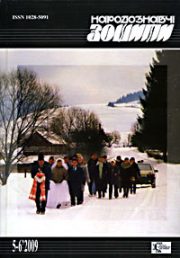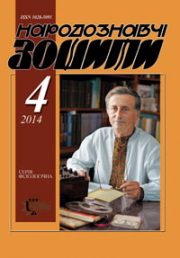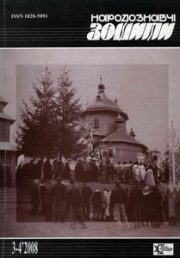The Ethnology Notebooks. 2022. № 3 (165), 549—561
UDK 7.046.3:27-312.8:069:7:(438.32)
DOI https://doi.org/10.15407/nz2022.03.549
THE IMAGES OF SAVIOR, CROWNED BY THORNS, FROM THE LVIV MUSEUM OF THE HISTORY OF RELIGION
AVULA Anastasiia
- ORCID ID: https://orcid.org/0000-0002-6968-7766
- Postgraduate student,
- National Academy of Fine Art and Architecture,
- 20, Voznesenskii uzviz, 04053, Kyiv, Ukraine,
- Contacts: e-mail: nata.avula@gmail.com
Abstract. The Comprehensive researches of iconography of Jesus Christ is conducting in the Ukraine and at abroad. However, the crown of thorns did not receive due attention. The exhaustive analysis plot of Christ, crowned of thorns, had generated on Ukrainian lands in the eighteenth — twentieth centuries, is going now. Attention paid to: features of flowering the plot in Europe with beginning of Renaissance; creative work of Ukrainian icon painters, inspired by Western European influence; the origin of book printing in Ukraine and its effect on icon painting; parallelism of plots in church and secular art.
The motif, had inspired by Western European influence, rooted in iconographic diversity of this time and occupied an important place in interpretations of secular painting, underwent rethinking in the artistic and religious aspect and further became a source of inspiration for contemporary Ukrainian artists. For example, the artworks, from collection of Lviv Museum of the History of Religion, analyzed and paid special attention to specifics of image crown of thorns. It had a lot of varieties depicted plot, peculiarities of the artistic language and compositional techniques.
The aim of the article is to study the iconographic types, features of interpretations of plots, analysis of sources of origin and comparison with analogues, on the example of works of XVIII-XX centuries, depicting the crowned thorns of Jesus Christ, stored in the Lviv Museum of Religious History.
Methodology. The methodological basis of the study is a systematic approach, methods of synthesis, generalization, comparative history and art analysis.
Research results. It is confirmed that this motif, inspired by Western European influence, is rooted in the iconographic diversity of the time and occupies an important place in the interpretation of secular painting, is rethought in the artistic and religious aspect and continues to be a source of inspiration for contemporary Ukrainian artists.
The scientific novelty lies in the introduction into scientific circulation of samples from the stock collection of the Lviv Museum of the History of Religion, which highlight the ways of Western European influence on the creative approaches of contemporary Ukrainian masters.
Practical significance. Research materials are useful in the process of studying the history of Ukrainian painting; analysis and synthesis of both individual iconographic types, with the participation of the crown of thorns of Jesus Christ, and the general picture of the artistic achievements of the XVIII—XX centuries; are necessary for the educational function and enrichment of creative approaches of modern Ukrainian artists and art critics.
Keywords: iconography, Christianity, instruments of passion, crown of thorns.
Received 4.05.2022
REFERENCES
- Nozhanskiy, G. About the saints and their guarantee. Retrieved from: http://www.pravenc.ru/text/161780.html (Last accessed: 31.08.2021) [in Russian].
- Calvin, J. (1543). Treatise on Relics. Retrieved from: https://ru.wikisource.org/wiki/%D0%A2%D1%80%D0%B0%D0%BA%D1%82%D0%B0%D1%82_%D0%BE_%D1 % 80% D0% B5% D0% BB% D0% B8% D0% BA% D0% B2% D0% B8% D1% 8F% D1% 85 (Last accessed: 31.08.2021) [in Russian].
- Alpatov, M. (1976). Artistic problems of the Italian Renaissance. Moscow: Art [in Russian].
- Vipper, B. (1966). Renaissance. Baroque. Classicism. Problem of styles in Western European art of the 15th—17th centuries. Moscow: Nauka [in Russian].
- Grenberg, Y. (2004). History of technology easel painting from Fayum portrait to post-impressionism. History of technology easel painting: two thousand years of evolution. Moscow: Art [in Russian].
- Dvorjak, M. (1978). History of Italian art of the Renaissance XIV and XV centuries (Vol. I). Moscow: Art [in Russian].
- Smirnova, I. (1987). Monumental painting of the Italian Renaissance. Moscow: Fine Arts [in Russian].
- Zholtovsky, P. (1987). Ukrainian painting of the 17th—18th centuries. Kyiv: Naukova dumka [in Ukrainian].
- Shchekoldina, N. (2019). Study drawings albums of Kyiv-Pechersk Lavra icon painting workshop (Kuzhbushki) from manuscript collections of the Vernadsky National Library of Ukraine: sc. cat.: two parts (Part I: Printed graphics of the sixteenth-eighteenth century Western European art schools). NAS of Ukraine; Vernadsky National Library of Ukraine; Institute of Manuscript. Kyiv. Retrieved from: http://irbis-nbuv.gov.ua/everlib/item/er-0003841 (Last accessed: 31.08.2021) [in Ukrainian].
- Stasenko, V. (2003). Christ and Mother of God at the wood cutters of the Cyrillic books of Galicia in the 17th century. Kyiv: Druk[in Ukrainian].
- Stepovik, D. (2004). The history of Ukrainian icon X—XX centuries (2 ed.). Kyiv: Libid [in Ukrainian].
- Krekhovetskiy, J. (2002). The icon is theologian and spirituality. Lviv: Svichado [in Ukrainian].
- Ovsiychuk, V., & Krvavich, D. (2000). The story of the icon. Lviv: The Ethnology Institute of National Academy of Sciences of Ukraine [in Ukrainian].
- Osadcha, O. Ukrainian folk (khatnya) icon XVIII—XX centuries as an ethnocultural phenomenon (history, typology, artistic specialties). Methodical development to the course Folk painting. Retrieved from: http://artisthelen.com/rozrobky/ukrayinska-narodna-hatnya-ikona-kintsya-xviii-xx-stolit-yak-etnokulturnyj-fenomen-istoriya-typologiya-hudozhni-osoblyvosti (Last accessed: 31.08.2021) [in Ukrainian].
- Makoyda, O. (2013). Ukrainian icons Passion of Christ XV—XVI centuries: stylistics and iconography. Christian sacred tradition: history and present. Proceedings of the International Scientific Conference. Lviv, December 6—7, 2013 (Pp. 32—42) [in Ukrainian].
- Maginskiy, V. (2012). Shroud of the XIX century. Apologist. Christian sacred tradition: faith, spirituality, art. Proceedings of the V International Scientific Conference. Lviv, November 23—24, 2012 (Pp. 175—178) [in Ukrainian].
- Fedak, M. (2013). Icons dated of the Last Judgment from the collection of the Andrey Sheptytskyi National Museum in Lviv. Bulletin of Lviv University. A series of art. (Vol. 13, pp. 182—198) [in Ukrainian].
- Kosiv, R. (2016). Spas — Vine. Icons from the collection of the Andriy Sheptytsky National Museum in Lviv. Lviv: Svichado.
- Kosiv, R. (2019). Rybotytsky center of church art 1670—1760s: (monograph). Lviv: Andriy Sheptytsky National Museum in Lviv [in Ukrainian].
- Karpiuk, L. (2011). The image Savior in the Thorns in religious painting of Volyn in the XVIII century. Volyn icon: research and restoration. Scientific collection. Proceedings of the XVIII International Scientific Conference. Lutsk, October 27—28, 2011 (Issue 18, pp. 89—93) [in Ukrainian].
- Vigodnik, A. (2014). Icons Christ of Boremel in Volyn. Volyn icon: research and restoration. Scientific collection. Proceedings of the XXI International Scientific Conference. Lutsk, October 16—17, 2014 (Issue 21, pp. 89—96) [in Ukrainian].
- Bible. New Testament. Translated by Ivan Ogienko. Gospel of Mark. Retrieved from: https://www.my-bible.info/biblio/ukrainskaya-bibliya/evangelie-ot-marka.html#g15 (Last accessed: 31.08.2021) [in Ukrainian].
- Utrecht’s psalter. Retrieved from: https://web.archive.org/web/20141210133529/http: //objects.library.uu.nl/reader/index.php? Obj = 1874-284427 & lan = nl # page // 88/76/28 /88762805735041331839304310876277162004.jpg/mode/1up (Last accessed: 31.08.2021) [in Latin].
- Avula, A. (2021). Images of Christ, crowned with thorns, in Ukrainian iconography 17—18 centuries. Eighth Platone’s Readings. Abstracts of additional articles of the International Science Conference (Kyiv, 21 November, 2020) (Pp. 12—13). Kyiv: SPD Chalchinska N.V. [in Ukrainian].
- Yurchenko, K. (2015). Symbolic and allegorical images of altars of the XVIII—XIX centuries as a factor of determining their functional purpose. Bulletin of National Academy of Culture and Arts Management, 1, 154—159 [in Ukrainian].
- Irmos of the ninth song of Kosma Mayumsky’s canon to Holy Saturday. Retrieved from: https://parafia.org.ua/biblioteka/bohosluzhbovi-knyzhky/triod-postova/svyata-i-velyka-subota/ (Last accessed: 31.08.2021) [in Ukrainian].
- Kanarskaya-Lutsan, O. (2010). Icons Savior Non-Manufactured from the collection of the Volodymyr-Volynskii Museum of Local Lore. Art History and Research (Pp. 52—61) [in Ukrainian].
- Skop, M. (2020). Ukrainian icons Savior Non-manufactured XV—XVI centuries: artistic features and semantics. The Ethnology Notebooks, 3 (153), 622—636 [in Ukrainian].
- Kosiv, R. (2010). Christ the Vine icons from the collection of National Museum in Lviv named after Andrei Sheptytsky (iconography, artistic features). Apologist. Proceedings of the II International Scientific Conference (Lviv, November 24—25, 2010) (Pp. 75—83) [in Ukrainian].






